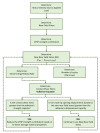Effects of Adhesive Bond-Slip Behavior on the Capacity of Innovative FRP Retrofits for Fatigue and Fracture Repair of Hydraulic Steel Structures
- PMID: 31071962
- PMCID: PMC6540136
- DOI: 10.3390/ma12091495
Effects of Adhesive Bond-Slip Behavior on the Capacity of Innovative FRP Retrofits for Fatigue and Fracture Repair of Hydraulic Steel Structures
Abstract
Over eighty percent of the navigation steel structures (NSS) in the United States have highly deteriorated design boundary conditions, resulting in overloads that cause fatigue cracking. The NSSs' highly corrosive environment and deterioration of the protective system accelerate the fatigue cracking and cause standard crack repair methods to become ineffective. Numerous studies have assessed and demonstrated the use of carbon fiber reinforced polymers (CFRP) to rehabilitate aging and deteriorated reinforced concrete infrastructure in the aerospace industry. Due to the increase of fatigue and fracture failures of NSS and the shortage of research on CFRP retrofits for submerged steel structures, it is imperative to conduct research on the effects of CFRP repairs on NSS, specifically on the adhesive's chemical bonding to the steel substrate. This was accomplished by developing a new analytical algorithm for CFRP bond-slip behavior, which is based on Volkersen's contact shear single lap joint (SLJ) connection. The algorithm was validated by experimental results of fatigue center-cracked large steel plates repaired with CFRP patches. The state of stresses at the crack tip are largely influenced by a combination of the crack tip plasticity radius and overall bond surface area.
Keywords: bond-slip; carbon fibers; cohesive damage; extended finite element; fatigue and fracture repairs; hydraulic steel structures; traction-separation.
Conflict of interest statement
The authors declare no conflict of interest. The funders had no role in the design of the study; in the collection, analyses, or interpretation of data; in the writing of the manuscript, or in the decision to publish the results.
Figures







References
-
- Riveros G.A., Arredondo E. Predicting Future Deterioration of Hydraulic Steel Structures with Markov Chain and Multivariate Samples of Statistical Distributions. J. Appl. Math. 2014;2014:360532. doi: 10.1155/2014/360532. - DOI
-
- Mahmoud H., Chulahwat A., Riveros G. Fatigue and Fracture Life-Cycle Cost Assessment of a Miter Gate with Multiple Cracks. Eng. Fail. Anal. 2018;83:57–74. doi: 10.1016/j.engfailanal.2017.09.008. - DOI
-
- Riveros G.A., Rosario-Pérez M.E. Deriving the Transition Probability Matrix Using Computational mechanics. Eng. Comput. 2018;35:692–709. doi: 10.1108/EC-02-2017-0051. - DOI
-
- Grier D. The Declining Reliability of the U.S. Inland Waterway System. U.S. Army Corps of Engineers Institute for Water Resources; Alexandria, VA, USA: 2005.
-
- Grossardt T., Bray L., Burton M. Inland Navigation in the United States an Evaluation of Economic Impacts and the Potential Effects of Infrastructure Investment. National Waterways Foundation; Washington, DC, USA: 2014.
Grants and funding
LinkOut - more resources
Full Text Sources
Medical
Research Materials
Miscellaneous

